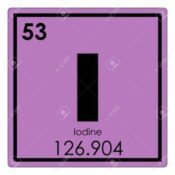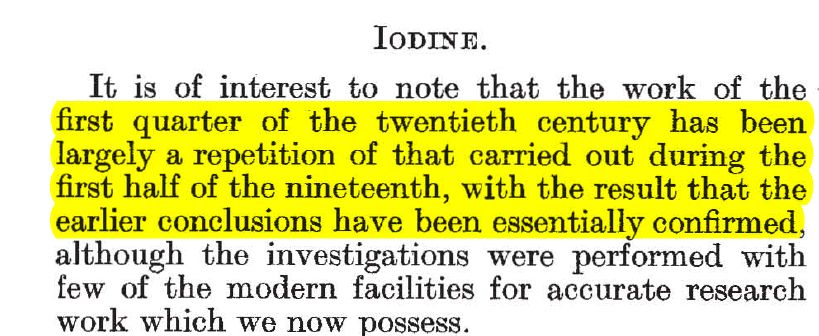Iodine Main
Updated May 4, 2024

Iodine Program
IMPORTANT NOTICE
This information is for educational purposes only, to facilitate quality conversations between patients and their personal physician(s). Several essential considerations are required to safely administer any protocol for an individual. This information is NOT intended to diagnose, treat or encourage self-treatment of any medical condition.
Iodine is the largest atom in the human body. It has unique features that power multiple functions, not just thyroid. While the thyroid system utilizes a large proportion of the body’s total iodine, the following tissues require iodine and cannot function properly without it: salivary glands, breast and prostate, stomach (secreted into the stomach during digestion), other locations in the gut, choroid plexus in the brain (which lines the mysterious fluid-filled ventricles), and other places. Every cell of the body is supplied with iodine when levothyronine (T4) is converted to liothyronine (T3), T2, and probably T1, releasing Iodide ions.
The World Health Organization’s position is that “iodine is the leading cause of reversible brain dysfunction in children”. Pre-natal or post-natal iodine or thyroid deficiency can cause problems with brain development, some of which is irreversible. Adult brain and optimal health require proper amounts of iodine while reducing the toxic effects of halide competitors bromine, chlorine (perchlorates) and fluorine.
Comparing Chloride with Iodide
Salt or sodium chloride has a maximum solubility in water of about 35%, while sodium iodide’s solubility at the same temperature is approximately 130%. This demonstrates that iodide has a much greater affinity for water than chloride, 3.7 x more when attached to sodium. For the potassium forms, both have higher solubilities than the sodium form. Solubility of potassium chloride is 75% while potassium iodide is 166%, or 2.2x more.
This affinity of iodide for water gives iodide some of its special features in influencing cellular biochemistry. In the iodine (I2) form, the affinity reverses, the molecule having high affiity for fatty molecules (see iodine number) and extremely low for water. In some ways, iodine can act as a “counter-agent”, by shifting between two opposite sides of the water-fat system.
More information will appear with registration as a subscriber, patient or member.
Iodine in Thyroid Hormone
- Tyrosine Molar Mass = 181.19,
x2 = 362.38 - Iodine Molar Mass 126.91; x2 = 253.8; x3 = 380.73; x 4= 507.64
- Note that the weight of T4 does NOT equal two tyrosines + 4 iodines since several atoms are removed when the tyrosines combine and when the iodines are attached to the tyrosines
- T4 molar mass is 776.87 grams/mol. C₁₅H₁₃I₄NO₄ Contains four iodine molecules = 507.64 gm; / 776.87 = 65.34% I
-
- 100 mcg T4 has 65.34 mcg of elemental iodine; 16.34 mcg released to make T3
- T3 molar mass is 650.98 grams/mol. Contains 3 iodine molecules = 380.73 gm; / 650.98 = 58.5 % I
- 5 mcg of T3 has ___ mcg of elemental iodine
- T2 molar mass is 525.09 grams/mol. Contains 2 iodine molecules = 253.8 gm; / 525.09 = 48.3% Iodine
- Di-Iodo-Tyrosine Molar Mass = 432.98. Contains 2 iodine molecules = 253.8 gm; / 432.98 = 58.62% Iodine
- Iodo-Tyrosine Molar Mass = 307.09. Contains 1 iodine molecule = 126.9 gm; / 307.09 = 41.32% Iodine
Iodine's Many Roles
Learn About Forms of Supplemental Iodine
Learn About Iodine Dosing
Podcasts
Stay Tuned!
Selected References from PubMed
Mineral-Metabolism-Iodine-and-Sulphur.1929.nature
Iodine Monograph Alternative Medicine Review amr iodine v15-3-273
Iodine- Deficiency and Therapeutic Considerations amr v13-2-116
The-Extrathyronine-Actions-of-Iodine-as-Antioxidant-Apoptotic-and-Differentiation-Factor…




